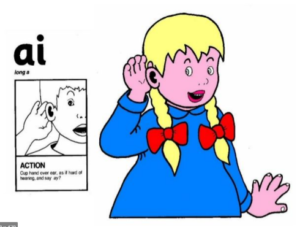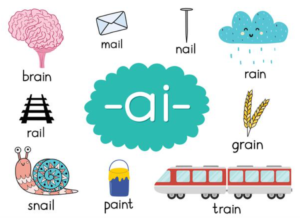Hey there! As a mommy blogger, I’m excited to share with you an easy and fun guide to help teach vowel digraphs to your little ones. Let’s make learning those tricky vowel pairs simple and engaging for kids!
The techniques I am going to share in this blog are the proven methods my daughter has been using throughout her two years in kindergarten, and I’ve seen great success with them!
Before diving into vowel digraphs, there are a few foundational concepts you’ll want to teach your child first. If you’ve already covered the basics, feel free to jump right into vowel digraphs!
What Are Phonics?
Phonics is a sound to a letter of an alphabet. To each letter, a sound is associated which may not sound the same as that of an alphabet.
Read also: Step by Step Guide To Teach Phonics to Children
Nowadays teaching phonics has become very easy due to the number of available stuff including flashcards, charts, videos, books, board games, and so on.
I found Jolly Phonics quite easy and good to start with for the kids. There’s a complete guide available.
Read also: Jolly Phonics – A Systematic and Sequential Learning Program for Kids
Once you get done with the phonics, you’re closer to teach vowel digraphs!
Download Free Phonics Worksheets For Kids.
How Can You Blend a Word?
Blending means joining the sound of the initial letter of work with the middle and end letter. As of now, this understanding would be more than enough for a kindergarten kid.
You start taking the sound of each alphabet and joining it to the next letter. For example, /c/ -/a/ – /t/ becomes cat.
Once you get a good grip on phonics, blending words will be much easier for you. I suggest you to start with three letter words first known as CVC words. To develop a good command over blending.
Read Also: How to Teach 3 Letter Words (CVC Words) : Step-by-Step Guide
Download Free Printable CVC Words (Three Letter Words) PDF Worksheets
Then you can proceed with 4 or 5 letter words, one the blending concept is fully grasped by your child.
Check out the blending words video here.
What Are the Vowels?
A, E, I, O, U – are the vowels.
For the kindergarten level kids, this would be the simplest method to make them learn the vowels.
There are 26 letters in English alphabets. Five of them are vowels (a, e, i, o, u). Rest of them are known as ‘consonants.’
Download Free Vowel Activity Worksheets From Phonics Worksheets Section.
What Are Digraphs?
Two letters, one sound.
That’s the easiest method to remember. And the children can learn it by heart.
Digraphs are basically the combination of two letters representing a single sound. Digraphs are an essential part of learning since they occur frequently in our language.
Learning digraphs makes reading easy for kids. There are many digraphs based on their sounds, some are divided in groups for better understanding.
Two letters which frequently occur together can frequently be seen as a form of digraph, may it be vowels or consonants.
What Are Vowel Digraphs?
Vowel digraphs are the digraphs in which at least one of the two letters is a vowel.
For example: ai, ea, oa, oe, ow, ay, and so on.
When a vowel is paired with either another vowel or a consonant, then that digraph is known as a vowel digraph.
The most common vowel digraphs include ai (rain), ay (day), ee (bee), ea (bear), oa (road), ou (loud), ue (blue), ie (pie), ow (slow).
Download Free Vowel Digraph Practice Worksheets.
How to Teach Vowel Digraphs?
Now as you’re done with the phonics, blending, and digraphs… Now it’s time to get started with the vowel digraphs!
Believe me, it’s fun to learn and practice these digraphs.
Introduce the basic digraphs first, like ai, then read them out the words containing ai digraph and the rhyming words. Like gain, brain, grain, drain.
For each digraph, there is an action associated with that. Teach them the action of the digraph. In this way, the kids can remember that for a long time. And they become able to pick up that digraph quickly by the action.
For example, the action of ai digraph is:

Then move forward with blending ai digraph in other words. Like rail, sail, jail, hail. Similarly, take them to another word step by step.
You can use pictorial representation initially to gain the basic understanding of the words. Use picture to teach the words.

Similarly, there are many board books, posters, and videos of digraphs available which can help you out in teaching the vowel digraphs.
<iframe width=”560″ height=”315″ src=”https://www.youtube.com/embed/IQMO7xwMRrk” title=”YouTube video player” frameborder=”0″ allow=”accelerometer; autoplay; clipboard-write; encrypted-media; gyroscope; picture-in-picture” allowfullscreen></iframe>
Differentiate between same sound digraphs
Now as you proceed with teaching the digraphs, there are chances that your child might get confuse. Because the sound of the digraph may vary from word to word.
For example, rain and day. The sounds are the same but the digraphs are different. Similarly, oi and oy have the same sound but different
Some are short sounds and some are long sounds (well that’s another story!).
For convenience, a chart is given below which will help you to identify the digraphs having the same sound, despite having different letters.
“ai” | rain, gain, sail |
“ay” | day, play, stay |
“ea” | read, beach, speak |
“ee” | feet, meet, sheet |
“ie” | brief, grief, thief |
“ie” | fries, tie, pie |
“oa” | boat, goat, road |
“oe” | canoe, horseshoe, snowshoe |
“oo” | book, foot, cook |
“oo” | zoo, noon, broom |
“ue” | argue, blue, glue |
“ui” | cruise, fruit, bruise |
This could be very tricky but kids nowadays are wise enough to pick up these differences very quickly.
One main aspect is that you should try to engage your child in learning activities. Like reading books, or showing them some stories on YouTube with the caption on.
These are the main sources that intrigue a child’s interest in reading and learning new words each day.
Final Words
In this blog, we covered vowels, phonics, and vowel digraphs.
While there are many more aspects to explore, we’ve simplified it by focusing on these key areas.
Download our vowel digraph worksheets made exclusively by MommyTutors to practice the digraphs.
More interesting learning blogs are coming soon!
Don’t forget to give your feedback.
Happy Learning!


